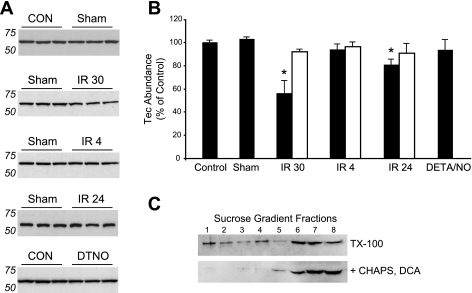Fig. 3.
Tec translocates to Triton X-100 (TX-100)-insoluble fractions after ischemia and reperfusion. A: Tec abundance was measured by Western blot analysis in ischemic and nonischemic regions of the same heart after solublization in Triton-X100 lysis buffer, which leaves lipid rafts insoluble. A significant decrease in Tec levels was detected after 30 min of ischemia and 30 min of reperfusion (IR 30 group) in the ischemic zone, whereas Tec was unchanged after 4 h of reperfusion (IR 4 group) and showed a smaller decrease after 24 h of reperfusion (IR 24 group). CON, control; Sham, mice subjected to sham operation; DTNO, DETA/NO treatment. n = 3 mice/group. B: quantified results from A. Importantly, these changes were only witnessed in the ischemic region of the heart (solid bars), not in the nonischemic region (open bars). No differences in basal Tec expression were detected between the base and apex of the heart (data not shown). DETA/NO treatment alone had no effect on Tec levels. *P < 0.05 vs. control. C: use of zwitterionic (CHAPS) and ionic [deoxycholate (DCA)] detergents and ultracentrifugation demonstrated the raft association of Tec. Fractions 1–8 were collected from the sucrose gradient representing the lowest to highest density. Note that in the absence of CHAPS and DCA, Tec was distributed across low-density fractions (top blot), indicative of insolubility, whereas additional detergents effectively extracted Tec from these low-density fractions (bottom blot).

